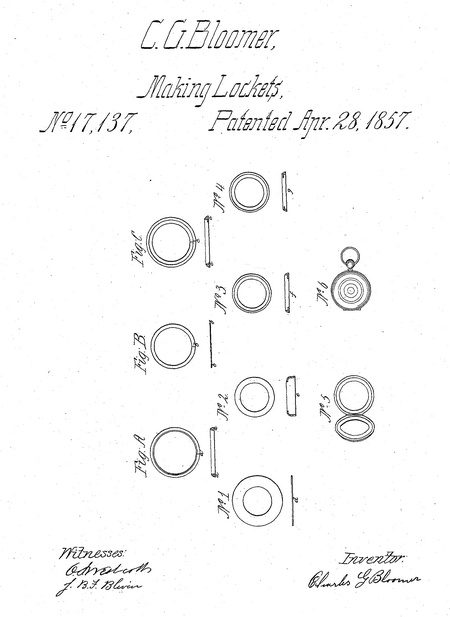Charles Gaffit Bloomer
- Born: 6 Jun 1827, New York City NY
- Marriage (1): Lillias A. Fisher in Jan 1849 in New York City NY
- Died: 14 Mar 1913, Pawtuxet RI
General notes:
Jeweler
Events in his life were:
- He worked circa 1849-1853 as a jeweler in New York City NY
- He worked in 1853-1858 as a jeweler in Warwick RI

- He was issued patent number 17,137 on 28 Apr 1857
CHARLES G. BLOOMER, OF WICKFORD, RHODE ISLAND.
CONSTRUCTING LOCKETS, &c.
Specification forming part of Letters Patent No. 17,137, dated April 28, 1857; Reissued November 15, 1859, No. 851
To all whom it may concern:
Be it known that I, Charles G. Bloomer, of Wickford, in the county of Washington and State of Rhode Island, have invented a new and useful Improvement in the Manufacture of Lockets; and I hereby declare the following to be a full and exact description thereof, reference being had to the accompanying drawings and to the letters of reference marked thereon.
Lockets are formed of two halves or sides, substantially alike, connected by a hinge, held shut by a spring catch, and suspended by a metallic ringlet passed through a stud or knob, so as commonly to resemble in material, form and finish, a gold-watch-case. The base of each side is a "rim," to which is fitted the plate that forms the outer case or back. This rim is made by uniting two rings of different sized and different shaped wires.
Figure A, represents an exterior ring, a section of the wire is shown at a, a, and the joint where the ends are soldered at a'.
Fig. B, shows the inner ring; b, b, a section of the flat wire of which it is made, and 6' the soldered joint.
Fig. C, shows the rings united and forming a "rim." The section of the compounded, wire being as represented at c, c, in one rim, and slightly varied in the other as circumstances may require. The object in thus combining a flat ring with the exterior one is to acquire a suitable recess or bed-plate for receiving the glass and its setting. The inner ring is known in the trade as the " field-piece." It will be perceived that in thus making the two rims of a locket there are six distinct soldering processes—the ends of the four wires being thus united, and the two inner rings soldered into the outer ones. Such is the common mode of manufacturing rims of lockets in both Europe and America. Now, in my improvement I dispense with these six soldering processes and produce at less cost, and in every respect, a better and more artistic article of jewelry.
Instead of two pieces of wire I make perfect rims out of single pieces of plate metal, by passing it through a series of stamps or dies.
In the following figures are represented the forms which a plain piece of metal puts on in the various dies. The jointed ends of the two rings of wire is shown at C.
No. 1, shows a planchet as first stamped out of a sheet, and the figure d below a section. No. 2. The next form it is made to assume is shown in plan; and in section at e. In No. 3, the " field-piece " is developed and the rim for one side of a locket completely formed. See the section, at /. In No. 4, the position of the field piece is slightly varied, and the rim for the other side of a locket completely formed. See the section at g. In No. 5, the two rims are united by the joint, and in No. 6, the complete locket is represented.
I am aware that sheet metal has been struck up into various forms, through series of dies, and for various purposes but neither the principle nor the process has been employed to the formation of the rims of lockets, probably because of the supposed impossibility of working "plated stock" of jewelers into the difficult form required, at the same time increase by accumulation the thickness of the metal at certain parts to two or three times that of the planchet.
I therefore claim as a new and useful contribution to this department of the arts:
1. The making of locket rims out of single pieces of metal instead of two or more which are everywhere used.
2. I claim the making of them out of sheet metal instead, of wire, and
3. I claim the making of them substantially in the manner herein described.
Charles G. Bloomer
Attest:
Geo. T. Nichols
Edwin Montgomery
- He worked in 1858-1864 as a jeweler in Wickford RI for the firm of ELDRED & Co.
- He appeared on the census in 1860 in North Kingston, Washington, RI. Listed as a mechanic.
- Partnership: Edwin Montgomery, in 1865-1867, in Warwick RI. As MONTGOMERY & BLOOMER.
- He appeared on the census in 1870 in Wickford RI. Listed as a jeweler.
- He appeared on the census in 1880 in Cranston RI. Listed as a manufacturing jeweler.
- He appeared on the census in 1900 in Cranston RI. Listed as a jeweler.
Charles married Lillias A. Fisher in Jan 1849 in New York City NY. (Lillias A. Fisher was born on 20 Apr 1829 in Canada and died on 20 Aug 1918.)
|

